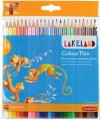Watercolor pencils
A type of pencil, usually coloured, with the lead is made of a special material that dissolves well with water (like watercolors — hence the name). At the same time, unlike regular watercolors, in this case you can make a dry paint. Actually, one of the options for using watercolor pencils just provides that the drawing is first drawn in the usual way, and then blurred with a brush in the right places to obtain softness and smooth colour transitions. You can also draw immediately on a wet sheet. Another option for using pencils of this type is a preliminary sketch for ordinary watercolor: if you choose the right colours, the lines of the sketch will practically disappear in a completed picture, dissolving in the paint. With a graphite pencil, this feature does not work.
A brush may be included to the package with watercolor pencils.
Lead Diameter
The thickness of the lead (writing rod) in a pencil or each crayon in a set (see "Product Type").
The meaning of this parameter depends on the specs of the pencil. So, in traditional pencils (lead in the casing), the thickness of the lead determines only the maximum thickness of the line that can be drawn in one pass. In collet models (see above), this parameter is also necessary to search for refill leads: their diameter must correspond to the size of the lead slot of the collet. And interchangeable leads with a diameter of more than 2 mm, usually, also have to be sharpened. However, anyway, each size is good for its tasks: thin leads are convenient for precise small work, and for large volumes of shading, it is desirable to have thicker pencils — they are not only more convenient, but also do not expend so fast.
As for the crayons, their thickness primarily determines the ease of use, as well as compatibility with special collet pencils that play the role of holders.

